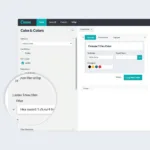Understanding your HbA1c test results can be crucial for managing diabetes. While you might be curious about “what color tube for HbA1c,” the color of the tube isn’t the most important factor. What truly matters is the accurate interpretation of the results and how they inform your diabetes management plan. This article will delve into the HbA1c test, its significance, and how to use the results effectively.
Decoding the HbA1c Test: What It Tells You
The HbA1c test, also known as the glycated hemoglobin test, provides a snapshot of your average blood sugar levels over the past two to three months. Unlike a fasting blood glucose test, which measures your blood sugar at a single point in time, the HbA1c offers a broader perspective on your blood sugar control. This is because it measures the percentage of hemoglobin, a protein in your red blood cells, that has glucose attached to it. The higher your blood sugar levels have been, the more glucose will be bound to hemoglobin.
What Color Tube for HbA1c? The Lavender-Top Tube
While the specific color can vary slightly depending on the laboratory, the most commonly used tube for HbA1c testing is lavender-topped. These tubes contain EDTA, an anticoagulant that prevents blood clotting. This is essential for accurate HbA1c measurements. While the tube color helps phlebotomists quickly identify the correct tube for the test, it’s the content of the tube (EDTA) that is crucial for accurate analysis.
Why EDTA Matters for HbA1c Testing
EDTA stabilizes the blood sample, ensuring that the glucose bound to hemoglobin remains consistent until the test is performed. This helps to prevent false readings. Other tubes with different anticoagulants might interfere with the HbA1c analysis.
Interpreting Your HbA1c Results
HbA1c results are typically reported as a percentage. For people without diabetes, a normal HbA1c level is generally below 5.7%. For people with diabetes, the target HbA1c level is typically below 7%, although individual targets may vary depending on specific circumstances and are best determined in consultation with a healthcare professional.
What do different HbA1c percentages mean?
- Below 5.7%: Normal
- 5.7% – 6.4%: Prediabetes
- 6.5% or higher: Diabetes
Beyond the Tube: Focusing on Long-Term Management
While knowing “what color tube for HbA1c” is relevant for blood collection, it’s the interpretation and application of the results that truly matter. Managing diabetes effectively requires a comprehensive approach that goes beyond just the test itself. This includes:
- Regular monitoring of blood sugar levels
- Healthy eating
- Regular physical activity
- Medication adherence (if prescribed)
- Working closely with your healthcare team
“Understanding your HbA1c and its implications for your overall health is far more critical than the color of the collection tube,” says Dr. Amelia Carter, MD, Endocrinologist. “It’s a valuable tool in managing diabetes, guiding treatment decisions, and ultimately, improving long-term health outcomes.”
Conclusion
While the lavender-topped tube is typically used for HbA1c testing, the focus should be on understanding what your HbA1c result means and how it can help you manage your diabetes effectively. By working closely with your healthcare team and adopting a holistic approach to diabetes management, you can improve your long-term health and well-being. Remember, the HbA1c test is a powerful tool for managing your diabetes, not just a number in a colored tube.
FAQ
- What does HbA1c stand for? HbA1c stands for Hemoglobin A1c.
- How often should I get my HbA1c checked? Your doctor will recommend a testing schedule based on your individual needs.
- Can I lower my HbA1c? Yes, through lifestyle changes and medication if necessary.
- Is the HbA1c test the same as a fasting blood glucose test? No, they measure different aspects of blood sugar control.
- What should I do if my HbA1c is high? Consult your doctor to discuss treatment options.
- Are there other tests used to monitor diabetes? Yes, including fasting blood glucose, random blood glucose, and oral glucose tolerance tests.
- What are the long-term complications of uncontrolled diabetes? Uncontrolled diabetes can lead to complications such as heart disease, nerve damage, kidney disease, and eye problems.
For further assistance, please contact us at Phone: 0373298888, Email: [email protected] or visit our office at 86 Cầu Giấy, Hà Nội. Our customer service team is available 24/7. You can also explore other articles on our website about diabetes management and blood sugar control.

